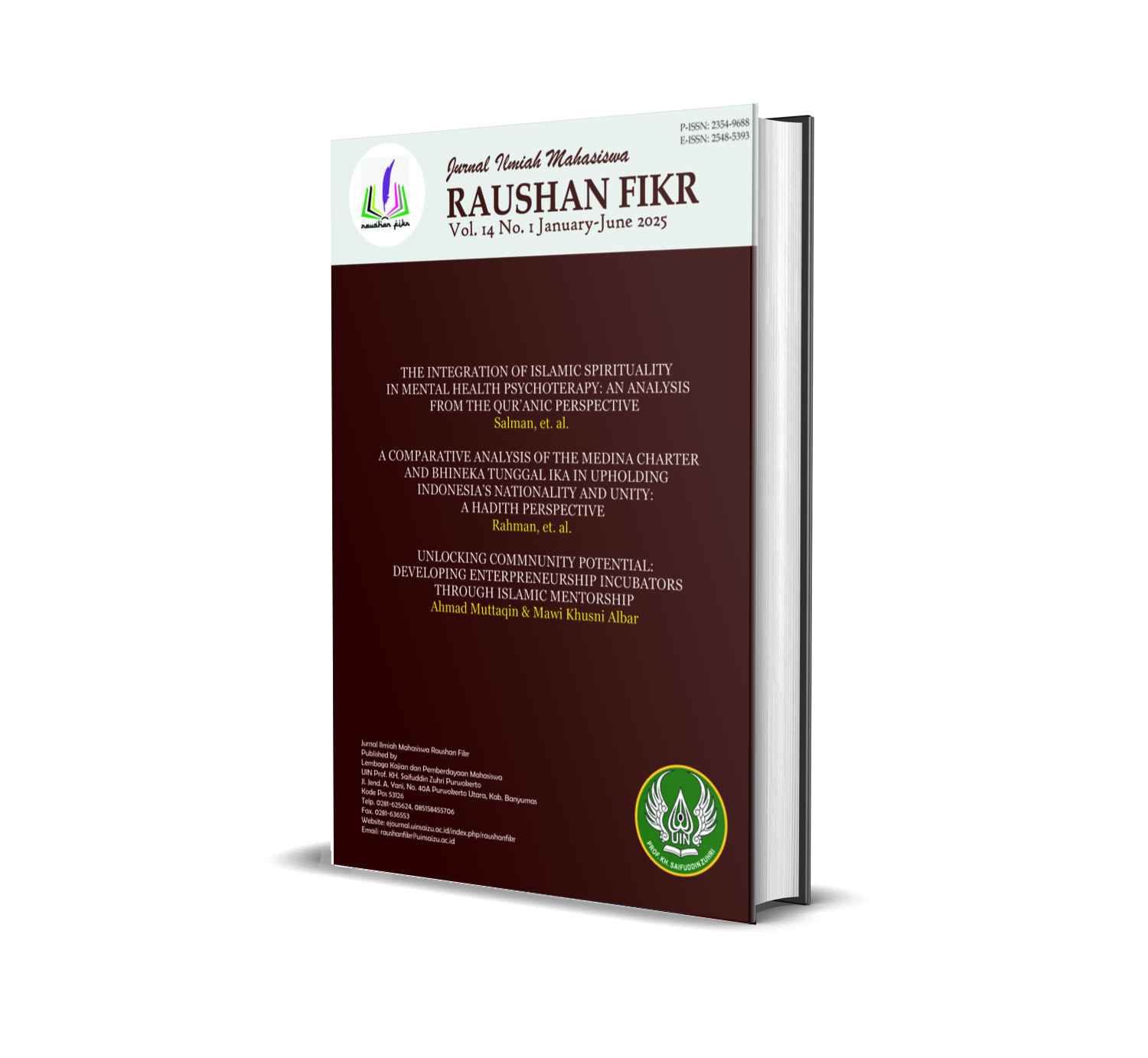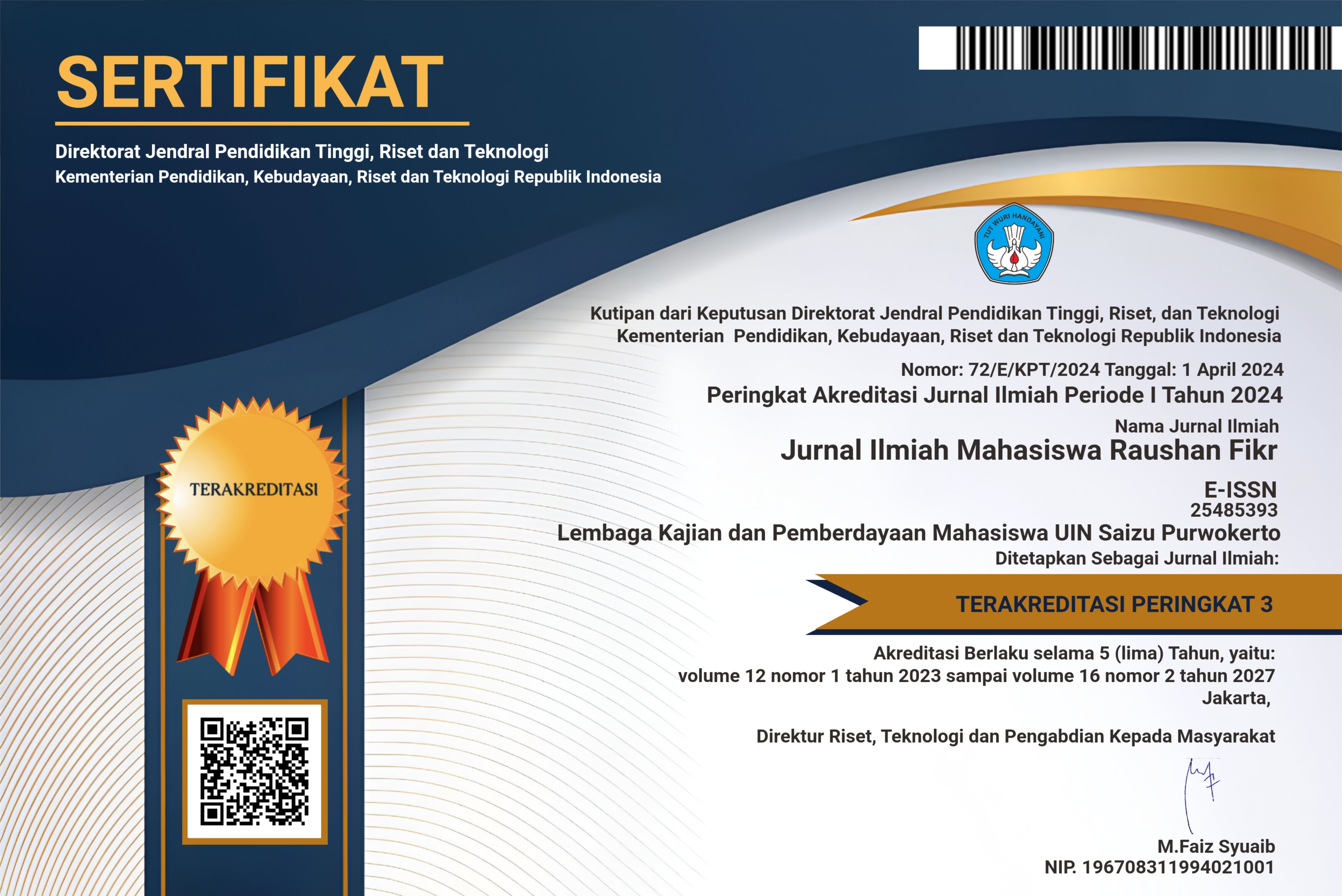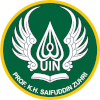From Revelation to Resilience: Qur’anic Ethics in Family Life and Their Role in Addressing Youth Moral Disruption
DOI:
https://doi.org/10.24090/jimrf.v14i1.12146Keywords:
Qur’anic Ethics, Family Education, Digital Era, Moral Resilience, Muslim YouthAbstract
The rapid integration of digital technology into daily life has significantly altered social behavior and moral norms, particularly among adolescents. This transformation has raised concerns about moral degradation within Muslim youth communities. This study investigates the relevance of Qur’anic character education in the family as a strategic response to these challenges. Employing a qualitative library research approach, the study analyzes primary and secondary sources—including Qur’anic exegesis and contemporary Islamic educational literature. Selected verses—Surah Luqman [31]: 12–19, Surah Maryam [19]: 30–34, Surah Al-An’am [6]: 151–153, Surah Al-Isra’ [17]: 23–24, and Surah Al-Hujurat [49]: 11–12—highlight core ethical principles such as gratitude, honesty, humility, and social responsibility. The findings reveal that when these values are instilled through family-based education, they form a resilient ethical framework capable of mitigating the disruptive moral effects of digital media. Qur’anic moral teachings serve as a cultural bridge across generations, reinforcing ethical awareness and preserving religious identity. The study calls for renewed attention to intra-family Qur’anic education as a vital form of cultural resistance and moral resilience in the digital eraDownloads
References
Abidin, Z. (2023). Demoralisasi Sosial Peserta Didik Dalam Pendidikan: Industrialisasi Kurikulum Di Universitas Pada Era Digital. Indonesian Journal of Social Science Education (IJSSE), 5(1), Article 1. https://doi.org/10.29300/ijsse.v5i1.8540
Agudelo Rico, D., Panesso Giraldo, C., Arbeláez Caro, J. S., Cabrera Gutiérrez, G., Isaac, V., Escobar, M. J., & Herrera, E. (2024). Moral Disengagement in Adolescent Offenders: Its Relationship with Antisocial Behavior and Its Presence in Offenders of the Law and School Norms. Children, 11(1), 70. https://doi.org/10.3390/children11010070
Aini, N. (2019). INTERNALISASI NILAI-NILAI PENDIDIKAN AGAMA ISLAM PADA KEGIATAN EKSTRAKURIKULER ROHANIAH ISLAM DALAM MEMBINA KARAKTER PESERTA DIDIK DI SMA NEGERI 1 AIR PUTIH KECAMATAN AIR PUTIH KABUPATEN BATU BARA. ANSIRU PAI : Pengembangan Profesi Guru Pendidikan Agama Islam, 3, 49. https://doi.org/10.30821/ansiru.v3i2.5849
Ainiyah, N. (2013). PEMBENTUKAN KARAKTER MELALUI PENDIDIKAN AGAMA ISLAM. Jurnal Al-Ulum, 13(1).
al-Jawzīyah, M. ibn A. B. I. Q. (2004). Madarij al-salikin. Dar al-Kotob al-’IImiyah.
al-Qushayri, ’Abd al-Karim ibn Hawazin. (2015). al-Risalah al-Qusyairiyah fi ’llm al-tasawwuf: Kajian sufistik Imam al-Qusyairi. Perniagaan Jahabersa.
Al-ghazali. (2014). Mutiara Ihya Ulumuddin. PT Mizan Pustaka.
Alsaleh, A. (2024). The impact of technological advancement on culture and society. Scientific Reports, 14(1), 32140. https://doi.org/10.1038/s41598-024-83995-z
Alwi, T., Badaruddin, K., & Febriyanti, F. (2023). Pelaksanaan Pembelajaran Tahfidz Al-Qur`An Dalam Membentuk Karakter Islami Siswa. Munaddhomah: Jurnal Manajemen Pendidikan Islam, 4, 756–766. https://doi.org/10.31538/munaddhomah.v4i3.466
Anwar, S., & Salim, A. (2018). Pendidikan Islam dalam Membangun Karakter Bangsa di Era Milenial. Al-Tadzkiyyah: Jurnal Pendidikan Islam, 9(2), Article 2. https://doi.org/10.24042/atjpi.v9i2.3628
Bandura, A. (1986). Social Foundations of Thought and Action: A Social Cognitive Theory. Prentice-Hall.
Bauman, Z. (2013). Liquid Modernity. John Wiley & Sons.
Berger, P. L., & Luckmann, T. (1967). The Social Construction of Reality: A Treatise in the Sociology of Knowledge. Knopf Doubleday Publishing Group.
Cohen, S. (2002). Folk Devils and Moral Panics: The Creation of the Mods and Rockers. Routledge.
Creswell, J. (2012). Research Design: Pendekatan Kualitatif, Kuantitatif, dan Mixed. Pustaka Pelajar.
Durkheim, É. (2001). The Elementary Forms of Religious Life. Oxford University Press.
Elsayed, W. (2024). Building a better society: The Vital role of Family’s social values in creating a culture of giving in young Children’s minds. Heliyon, 10(7), e29208. https://doi.org/10.1016/j.heliyon.2024.e29208
Erikson, E. H. (1968). Identity Youth and Crisis. W. W. Norton.
Foucault, M. (1995). Discipline and Punish: The Birth of the Prison. Knopf Doubleday Publishing Group.
Gramsci, A. (1971). Selections from the Prison Notebooks of Antonio Gramsci. International Publishers.
Hajaroh, M. (2010). Paradigma, Pendekatan dan Metode Penelitian. UNY Press.
HAMKA. (n.d.). Tafsir Al-Azhar. Pustaka Panjimas.
Hirschi, T. (2002). Causes of Delinquency. Transaction Publishers.
Irpan, I., & Sain, Z. H. (2024). The Crucial Role of Islamic Religious Education in Shaping Children’s Character: Psychological and Spiritual Review. QALAMUNA: Jurnal Pendidikan, Sosial, Dan Agama, 16(1), 383–392. https://doi.org/10.37680/qalamuna.v16i1.4902
Isma’il ’Ali, S. (n.d.). Usul al-tarbiyah al-Islamiyah. Dar al-Masirah.
Jaiyeoba, H. B., Ushama, T., & Amuda, Y. J. (2024). The Quran as a Source of Ethical and Moral Guidance in Contemporary Society: Al-Quran Sebagai Sumber Panduan Etika dan Moral dalam Masyarakat Kontemporari. Al-Irsyad: Journal of Islamic and Contemporary Issues, 9(2), Article 2. https://doi.org/10.53840/alirsyad.v9i2.485
Lickona, T. (1992). Educating for Character: How Our Schools Can Teach Respect and Responsibility. Bantam.
Matza, D. (2018). Delinquency and Drift. Routledge.
Maula, A. R. (2021). Pendidikan Karakter dalam Islam: Analisis Filosofis Ibnu Miskawaih dalam Kitab Tahzibul Akhlak. Jurnal Ilmiah Mahasiswa Raushan Fikr, 10(1), 68–76. https://doi.org/10.24090/jimrf.v10i1.4684
Mirakhor, A., & Askari, H. (2010). Islam and the path to human and economic development (1st ed). Palgrave Macmillan.
Moleong, L. J. (2006). Metode Penelitian Kualitatif. PT. Remaja Rosdakarya.
Nuriman, N., & Fauzan, F. (2017). The Influence of Islamic Moral Values on the Students’ Behavior in Aceh. Dinamika Ilmu, 275–290. https://doi.org/10.21093/di.v17i2.835
Qaida, M. A., & Rhain, A. (2024). Characteristics of a Muslim Youth in the Qur’an Surah Yusuf, Verse 33, to Address Moral Decadence and the Free Lifestyle of Gen Z. Proceeding ISETH (International Summit on Science, Technology, and Humanity), 2417–2426. https://doi.org/10.23917/iseth.5158
Rębisz, S., Jasińska-Maciążek, A., Grygiel, P., & Dolata, R. (2023). Psycho-Social Correlates of Cyberbullying among Polish Adolescents. International Journal of Environmental Research and Public Health, 20(8), 5521. https://doi.org/10.3390/ijerph20085521
Shihab, M. Q. (2012). Tafsir al-Mishbāh: Pesan, kesan, dan keserasian al-Qur’an. Lentera Hati.
Soheh, M., & Kulsum, U. (2021). Pendidikan IMPLEMENTASI MORAL TRIANGLE LICKONA DALAM MEMBENTUK KARAKTER YANG BAIK DAN KARAKTER AKHLAK KENABIAN MUHAMMAD SAW BAGI SISWA. AHSANA MEDIA: Jurnal Pemikiran, Pendidikan Dan Penelitian Ke-Islaman, 7(02), Article 02. https://doi.org/10.31102/ahsanamedia.7.02.2021.21-29
Downloads
Published
How to Cite
Issue
Section
License
Copyright (c) 2025 Siti Asiyah Dalimunthe, Satria Adi Pradana

This work is licensed under a Creative Commons Attribution-NonCommercial-ShareAlike 4.0 International License.
Authors who publish with this journal agree to the following terms:
- Authors retain copyright and grant the journal right of first publication with the work simultaneously licensed under a Creative Commons Attribution-NonCommercial-ShareAlike 4.0 International License that allows others to share the work with an acknowledgement of the work's authorship and initial publication in this journal.
- Authors are able to enter into separate, additional contractual arrangements for the non-exclusive distribution of the journal's published version of the work (e.g., post it to an institutional repository or publish it in a book), with an acknowledgement of its initial publication in this journal.
- Authors are permitted and encouraged to post their work online (e.g., in institutional repositories or on their website) prior to and during the submission process, as it can lead to productive exchanges, as well as earlier and greater citation of published work (See The Effect of Open Access).
















